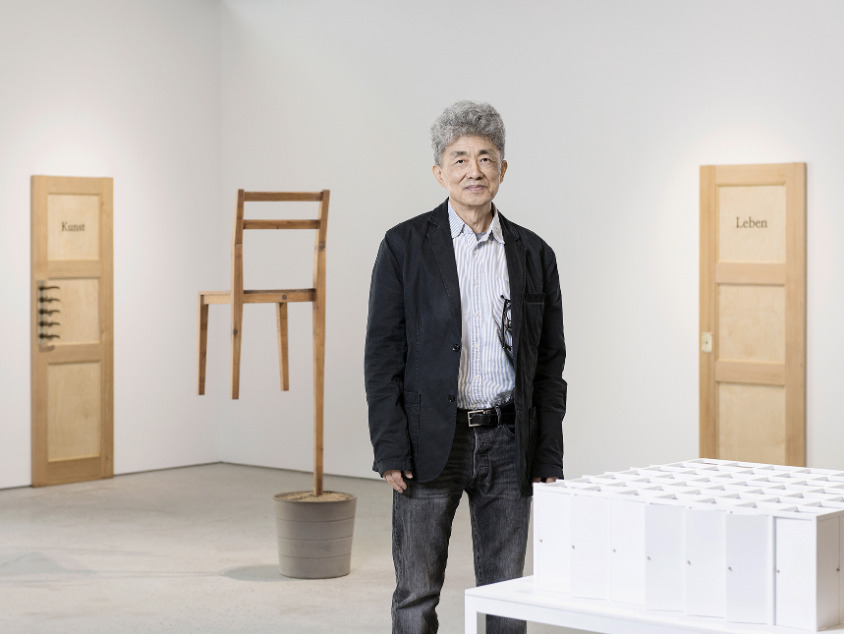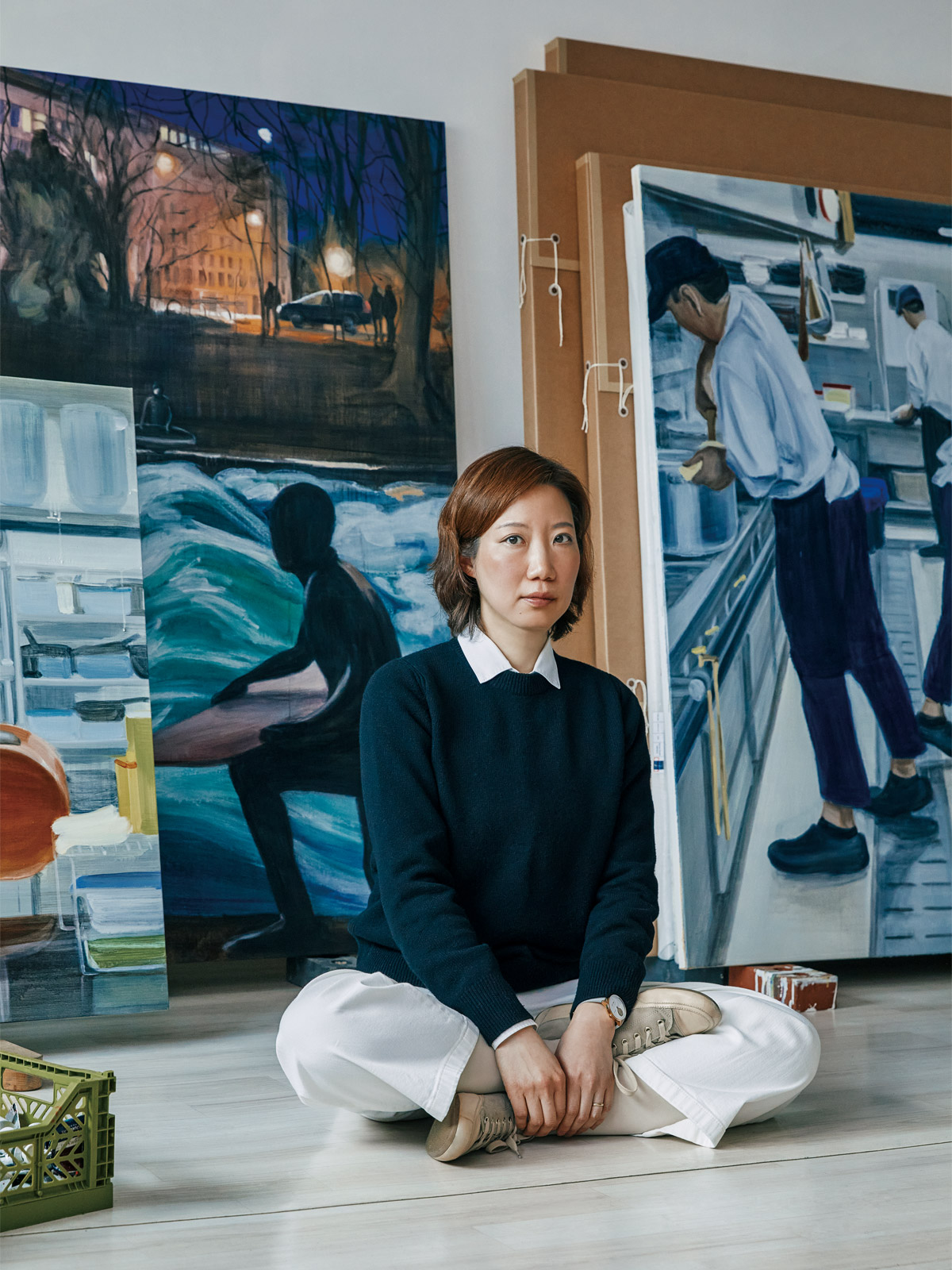Artist Ahn Kyuchul (b. 1955) has been relentlessly seeking alternative prospects of contemporary art through profound examination on life and art since the mid-1980s. Acclaimed for his complex yet delicate artistic vocabulary incorporating reflections on daily life, as well as close observations of everyday objects and language, Ahn has constructed a body of work. His visual language, deeply rooted in a conceptual approach and oblique representations of reality, allows viewers to reassess the essence of human nature and objects while confronting the irrationalities and paradoxes of modern life.
 Ahn Kyuchul, Scenery
of Jeong-dong, 1985 ©MMCA
Ahn Kyuchul, Scenery
of Jeong-dong, 1985 ©MMCAAhn is known for his immersion in the
conceptual nature of objects, but when he began his work in the early to
mid-80s, he also produced works that reflected the reality of Korean society at
the time. Entering university around the time of the Yunshin Reformation in 1972,
Ahn spent his university years in a repressed atmosphere and a conservative
atmosphere in which non-academic art was not recognized.
In this environment, the artist
naturally developed a critical consciousness of the established art world and
society and became a member of the 'Reality and Utterance' group of critics and
artists who sought to reflect the socio-political reality of Korea in their art.
During the politically turbulent 1980s
in South Korea, the artist created miniature works on the veranda of his home,
using very simple materials to recreate real-life events. Scenery of
Jeong-dong (1985) is a miniature sculpture of university students breaking
through security and climbing over a fence to a building flying an American
flag to protest, a scene the artist witnessed on the Deoksugung Stonewall,
which he passed by every day.
Ahn's satirical series of works
depicts real-life events that occurred in the political shadows of the time in
small, fairytale-like sculptures.
 Ahn Kyuchul, Unrighteous
Brush, 1992 ©MMCA
Ahn Kyuchul, Unrighteous
Brush, 1992 ©MMCAIn the
mid-1980s, Ahn began creating works as "narrative sculptures" that
challenged the practices of the art world and exposed the problems facing
society. His work has since evolved into subverting habituated notions of
everyday objects by creating objects that are located on the borderline between
object and sculpture, and adding speculative language to them.
Unrighteous Brush (1992),
which was exhibited in a solo exhibition during the artist's studies in
Germany, is one of the works that reveals the order and contradictions behind
the invisible by overturning the common sense notion of objects, which is a
constant theme in Ahn's work.
By
carving the word “죄 (its English equivalent would be
“sin”)" into the bristles of a brush, an everyday object made by the
artist himself, the work reminds us to reconsider the purpose of the brush,
which is to pick up dust and dirt, and metaphorically reveals the violence and
absurdity of common sense in the world through everyday objects.

Ahn Kyuchul, The Man’s Suitcase, 1993 ©Kukje Gallery
In the 1990s, while studying abroad in Germany, the artist began to intertwine drawing and text into a single work. At that time, he was introduced to the German school's critical class method of verbally explaining and asking questions about his work, which was a breakthrough for an artist who had studied within the established art world in Korea. Since then, he has been working in such a way that when he sketches an idea, he writes down the related thoughts in writing so that the writing and the painting can be connected as a single work.

Ahn Kyuchul, The Man’s Suitcase, 1993 ©Kukje Gallery
For
example, The Man's Suitcase (1993), an installation consisting of eleven
drawings with sketches and corresponding text and a wing-shaped suitcase sculpture,
was an experimental work that used text to link fictional narratives to
objects.
It is
also a representative work that concentrates on the theme of 'fiction and
reality' that runs through Ahn's work. Next to 11 drawings that tell the story
of a wing-shaped suitcase entrusted to an unknown man, the suitcase, which is
the central material of the story, is placed in front of the viewer as if it
were presented as concrete evidence of the story.
The
viewer is forced to consider whether or not to believe the fictional story in
the face of this concrete evidence. Through this work, Ahn suggests that
reality and fiction are intertwined like a web and can never be separated, and
the viewer experiences the moment of intertwining and perceives the double web
of meanings in our visual culture and symbols.

Ahn Kyuchul, Room With 112 Doors, 2004 ©The Hankyoreh
Since then, Ahn's work that crosses
the boundaries of the genre has expanded into the realm of architecture, or
space. Room With 112 Doors, presented in his solo exhibition “Forty-Nine
Rooms” at Rodin Gallery in 2004, was the first step in his architectural work.
Starting with the question of how to
tell universal stories related to our society within the space of an existing
exhibition hall, the artist created doors that we encounter and open and close
in 'real life'. Even if the viewer opens all 112 doors and enter the same room,
the same room is repeated, giving the viewer the experience of tautology, where
the act of opening the door becomes meaningless, and at the same time, the
experience of standing on the border between openness and closure, where the
viewer never knows when someone will enter the small space with doors on all
sides.
Through these labyrinthine spaces, the
artist conveys the story of the repetitive and boring daily life of modern
people who expect a better future but are no different from yesterday, and the
boundary between others and themselves in modern society in a way that the
viewer can directly experience it.
In addition, the artist has continued
to work on architectural works about space and residential environments,
recontextualizing objects that contain the reality of our society into works of
art, such as bringing in materials that have become obsolete due to
reconstruction, or building a house with door frames picked up from abandoned
houses.

Ahn Kyuchul, 1,000 Scribes, 2015 ©MMCA
Selected
for the Hyundai Motor Series at the National Museum of Modern and Contemporary
Art Korea in 2015, Ahn's "Invisible Land of Love" expands on his
previous works that intertwine various artistic genres and present them to the
viewer as a single work, inviting reflection on life.
Conceived
based on the artist's thought, "What if each work becomes a sequence and
functions as a story like a literary work?", the exhibition is composed of
interdisciplinary works encompassing literature, architecture, music, video,
performance, and publishing that intertwine with the viewer. The title of the
exhibition is a quote from a poem by the poet Mah Chonggi, which aims to reveal
the absence of things in the 'here-and-now' and to reflect on their meaning.
The
artist has chosen to present the exhibition not in a conceptual and complex
way, but in a way that anyone can partially participate in the creation of the
artwork, so that the intention of the exhibition can be easily understood
through the five senses. For example, 1,000 Scribes invited
over 1,000 visitors to transcribe literary works for an hour during the
exhibition, and Wall of Memories was an audience-participation work in
which visitors' notes were gathered to form a giant wall.
In this
way, Ahn invites the audience to participate in his work, and aims to create a
community of solidarity and empathy by uncovering and connecting the
'invisible' thoughts behind the images that flood our surroundings, beyond the
sensory stimulation of images.
"I'm
interested in making small, silly jokes with the objects and texts around me. I
do this not because I am indifferent to the important things that people are
preoccupied with, or because I am oblivious to the seriousness of these
realities, but rather because I cannot obediently surrender to this
overwhelming reality that puts our lives in such a survival-or-die situation.
I'm
not against serious art, I'm not against art as a sensory spectacle, but I
doubt that they really expand our thinking about other possibilities in our
lives. I am against art that settles for typical and predictable reactions and
solutions." (Ahn Kyuchul, All And But
Nothing, Workroom, 2014, p. 331)

Artist Ahn Kyuchul ©Kukje Gallery
Ahn
Kyuchul received his BFA in Sculpture from Seoul National University and worked
as a journalist for Art Quarterly from 1980 through 1987. He then moved
to Paris in 1987, and to Germany in 1988, graduating from the State Academy of
Fine Arts Stuttgart in 1995 after completing both undergraduate and graduate
programs. From 1997 to 2020, he taught at the School of Visual Arts, Korea
National University of Arts.
Major
solo exhibitions include “Words Just for You” at Kukje Gallery, Seoul (2017); “Invisible
Land of Love” at the National Museum of Modern and Contemporary Art, Seoul
(2015); “All and but Nothing” at HITE Collection, Seoul (2014); and “Forty-Nine
Rooms” at Rodin Gallery, Seoul (2004).
Ahn has
also participated in numerous group exhibitions at institutions and biennales
including “Variations of the Moon” at the Nam June Paik Art Center, Yongin
(2014); “ROUNDTABLE: The 9th Gwangju Biennale” (2012); “Void in Korean Art” at
Leeum, Samsung Museum of Art, Seoul (2007); and “Parallel Life” at Frankfurter
Kunstverein (2005).
References
- 국립현대미술관, MMCA 현대차 시리즈 2015: 안규철 - 안 보이는 사랑의 나라 (National Museum of Modern and Contemporary Art Korea, MMCA HYUNDAI MOTOR SERIES 2015: AHN KYUCHUL - Invisible Land of Love) :
- 국제갤러리, 사물의 뒷모습 (Kukje Gallery, The Other Side of Things) :
- 국립현대미술관, 안규철 | 죄많은 솔 | 1992 (National Museum of Modern and Contemporary Art Korea, AHN Kyuchul | Unrighteous Brush | 1992) :
- 국립현대미술관, 안규철 | 그 남자의 가방 | 1993 (National Museum of Modern and Contemporary Art Korea, AHN Kyuchul | The Man’s Suitcase | 1993) :
- 국립현대미술관, MMCA 작가와의 대화 | 안규철 작가 (National Museum of Modern and Contemporary Art Korea, MMCA Artist Talk | Ahn Kyuchul) :



















